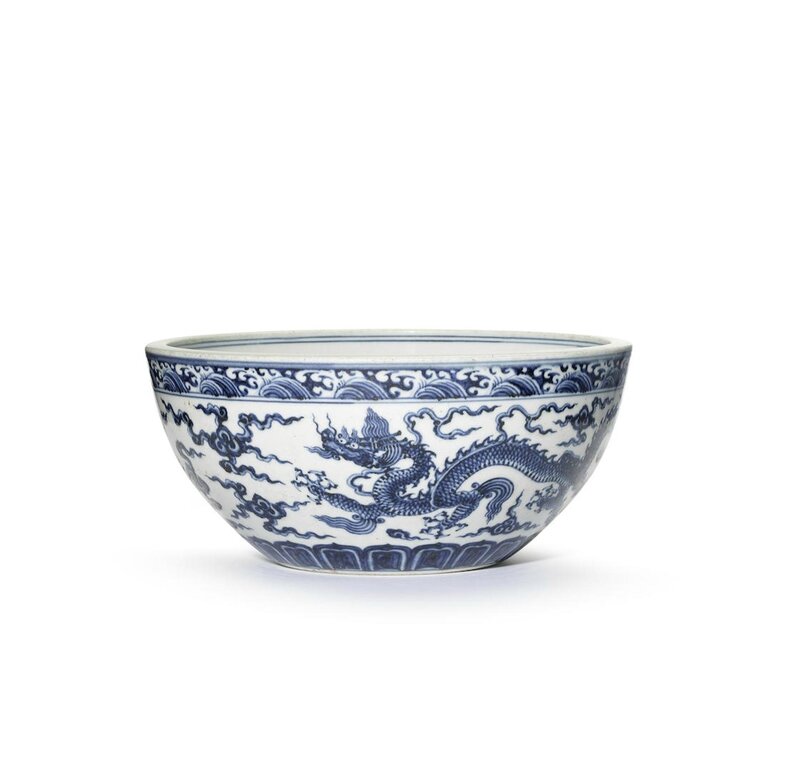A blue and white 'dragon' dice bowl, Xuande six-character mark and of the period (1426-1435)
Lot 2. A blue and white 'dragon' dice bowl, Xuande six-character mark and of the period (1426-1435). Estimate HK$ 800,000 - 1.2 million (€92,000 - 140,000). Photo: Bonhams.
Provenance:A European private collection, by repute
Notes: Bowls of this type, often described as 'dice bowls', are characteristically thickly and deeply potted, with the name denoting their possible use in the dice-throwing game. Dice bowls may be a Xuande period innovation, as previous examples have not been found.
Although the reign of the Xuande emperor lasted for only ten years (1426-35), its contribution to the development of porcelain production and output cannot be understated. The Xuande emperor was close in artistic sensibility to his grandfather, the Yongle emperor, under whose reign Imperial porcelain production at Jingdezhen developed rapidly and encouraged a spirit of creativity along with rigorous standards at the kilns. The custom of denoting the Imperial reign on vessels produced in the Imperial kiln began in the Yongle period but more often as incised four-character marks; the custom continued in earnest from the Xuande period and throughout the Ming and Qing dynasties.
Compare a similar dice bowl excavated at the Zhushan Imperial kilns in 1983, illustrated in Yuan's and Ming's Imperial Porcelains Unearthed from Jingdezhen, Beijing, 1999, pl.126. Other examples can be found in important museum collections: see two examples of dice bowls, of similar shape and dragon decoration, illustrated in A Panorama of Ceramics in the Collection of the National Palace Museum: Hsüan-te Ware I, Taipei, 2000, pls.34 and 35; another example is illustrated in The Complete Collection of Treasures of the Palace Museum: Blue and White Porcelain with Underglaze Red (I), Hong Kong, 2000, pl.124; see also one in the Victoria and Albert Museum, London, illustrated by J.Ayers, Far Eastern Ceramics in the Victoria and Albert Museum, London, 1980, pl.148; and in the Sir Percival David Collection in the British Museum, London; and in the Freer Gallery of Art, Washington D.C., published in Oriental Ceramics: The World's Great Collections, vol.6, Tokyo, 1982, pl.97, and vol.9, Tokyo, 1981, pl.104, respectively.
A similar blue and white 'dragon' dice bowl, Xuande mark and period, was sold at Sotheby's Hong Kong on 10 April 2006, lot 1659.
Bonhams. AUCTION 23347: FINE CHINESE CERAMICS AND WORKS OF ART, 10:00 HKT - HONG KONG, ADMIRALTY

/https%3A%2F%2Fprofilepics.canalblog.com%2Fprofilepics%2F1%2F0%2F100183.jpg)
/https%3A%2F%2Fstorage.canalblog.com%2F03%2F02%2F119589%2F96711876_o.jpg)
/https%3A%2F%2Fstorage.canalblog.com%2F11%2F31%2F119589%2F94773502_o.jpg)
/https%3A%2F%2Fstorage.canalblog.com%2F20%2F83%2F119589%2F94772815_o.jpg)
/https%3A%2F%2Fstorage.canalblog.com%2F26%2F72%2F119589%2F75604929_o.jpg)
/https%3A%2F%2Fstorage.canalblog.com%2F59%2F60%2F119589%2F26458628_o.jpg)




/image%2F1371349%2F20240416%2Fob_2a8420_437713933-1652609748842371-16764302136.jpg)
/image%2F1371349%2F20240414%2Fob_83ee65_2024-nyr-22642-0954-000-a-blue-and-whi.jpg)
/image%2F1371349%2F20240414%2Fob_15808c_2024-nyr-22642-0953-000-a-blue-and-whi.jpg)
/image%2F1371349%2F20240414%2Fob_e54295_2024-nyr-22642-0952-000-a-rare-blue-an.jpg)